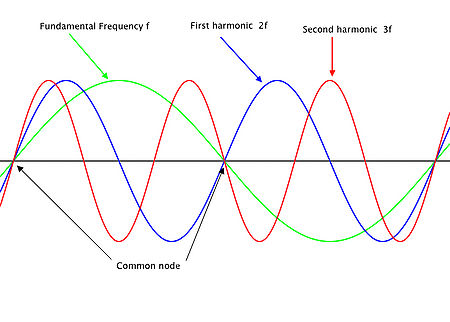Harmonics: Difference between revisions
TheAnarcat (talk | contribs) No edit summary |
m (→What is a harmonic?: Addition of harmonic examples delineation) |
||
| Line 1: | Line 1: | ||
==What is | ==What is a harmonic?== | ||
An harmonic of a particular frequency (the fundamental frequency '''f''') is | An harmonic of a particular frequency (the fundamental frequency '''f''') is a frequency that is an integer multiple of the first one. For example: | ||
if f = | if f = 125 MHz, the harmonics would be: | ||
1st harmonic = 1f = 125 MHz | |||
2nd harmonic = 2f = 250 MHz | |||
3rd harmonic = 3f = 375 MHz | |||
4th harmonic = 4f = 500 MHz | |||
..... etc. | |||
In the diagram below it can be seen that harmonics share common nodes. | In the diagram below it can be seen that harmonics share common nodes. | ||
| Line 9: | Line 15: | ||
[[Image:Vk4yeh_harmonics.jpg |450px]] | [[Image:Vk4yeh_harmonics.jpg |450px]] | ||
(this diagram is mislabeled, since 2f should be the 2nd harmonic) | |||
Mathematically, the basic wave equation is: | Mathematically, the basic wave equation is: | ||
Revision as of 08:13, 20 April 2015
What is a harmonic?
An harmonic of a particular frequency (the fundamental frequency f) is a frequency that is an integer multiple of the first one. For example:
if f = 125 MHz, the harmonics would be:
1st harmonic = 1f = 125 MHz 2nd harmonic = 2f = 250 MHz 3rd harmonic = 3f = 375 MHz 4th harmonic = 4f = 500 MHz ..... etc.
In the diagram below it can be seen that harmonics share common nodes.
 (this diagram is mislabeled, since 2f should be the 2nd harmonic)
(this diagram is mislabeled, since 2f should be the 2nd harmonic)
Mathematically, the basic wave equation is:
<math> \mathit{v}=\mathit{f}\times \lambda </math>
v is the velocity of the wave in metres per second - a constant close to the speed of light for radio waves in the atmosphere.
f is the frequency of the wave - how many cycles pass a fixed point per second
<math> \lambda </math> is the wavelength of the wave in metres - the distance between two peaks of the wave.
So, as the frequency increases, the wavelength decreases - a doubling of frequency causes a halving of wavelength etc.
Where do harmonics come from?
Why are harmonics bad?
How do you get rid of harmonics?
External links
See also
| Electronic Theory | |
| Physical quantities | Current * Gain * Impedance * Power * Q of a circuit * Radiated Power Measurement * Reactance* Resistivity * Resonance * Voltage |
| Components | Baluns * Bipolar-Junction Transistors * Capacitors * Diodes * Inductors* Lasers * Microphones * Resistors * Transformers * Wire |
| Circuits | Attenuators * Digital Signal Processing (DSP) * Dummy load * Filters * LC filters * Power Supply Design * Rectifier Circuits |
| Design | Amplifier Design * Oscillator Design |
| Electromagnetic Waves | Relative power (Decibels) * Harmonics * Interference and BPL |